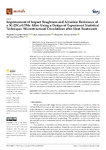Mostrar o rexistro simple do ítem
Improvement of Impact Toughness and Abrasion Resistance of a 3C-25Cr-0.5Mo Alloy Using a Design of Experiment Statistical Technique: Microstructural Correlations after Heat Treatments
| dc.contributor.author | González-Pociño, Alejandro | |
| dc.contributor.author | Asensio-Lozano, Juan | |
| dc.contributor.author | Álvarez-Antolín, J. F. | |
| dc.contributor.author | García-Diez, Ana | |
| dc.date.accessioned | 2021-05-03T15:13:35Z | |
| dc.date.available | 2021-05-03T15:13:35Z | |
| dc.date.issued | 2021 | |
| dc.identifier.citation | González-Pociño, A.; Asensio-Lozano, J.; Álvarez-Antolín, F.; García-Diez, A. Improvement of Impact Toughness and Abrasion Resistance of a 3C-25Cr-0.5Mo Alloy Using a Design of Experiment Statistical Technique: Microstructural Correlations after Heat Treatments. Metals 2021, 11, 595. https://doi.org/10.3390/met11040595 | |
| dc.identifier.issn | 2075-4701 | |
| dc.identifier.uri | http://hdl.handle.net/2183/27882 | |
| dc.description.abstract | [Abstract] Hypoeutectic high chromium white cast irons are commonly used in the mining and cement industries, where high resistance to abrasive wear is demanded. Through the application of a Design of Experiment technique (DoE), different factors related to thermal industrial treatments are analysed with regard to resistance to abrasive wear and impact response. Abrasion tests were carried out in accordance with the ASTM G065-16 standard. The provisional results show that to increase wear resistance, high destabilisation temperatures (1050 ◦C) followed by slow cooling to room temperature (RT) and subsequent tempering at 400 ◦C are most favourable. This is because these conditions are favourable to maintaining a certain tetragonality of the martensite after tempering and also, because of the presence of a high density of mixed carbides M7C3, through a secondary precipitation during cooling. Oil quenching and a high tempering temperature (550 ◦C) with long dwell times of 6 h were found to increase impact toughness. These conditions favour a lack of retained austenite. The presence of retained austenite was found unfavourable for both wear resistance and toughness, whereas tempering at 400 ◦C has been shown to be insufficient to transform martensite on tempering, which in turn seemed to increase the hardness of the matrix constituent. | es_ES |
| dc.language.iso | eng | es_ES |
| dc.publisher | MDPI | es_ES |
| dc.relation.uri | https://doi.org/10.3390/met11040595 | es_ES |
| dc.rights | Atribución 4.0 Internacional | es_ES |
| dc.rights.uri | http://creativecommons.org/licenses/by/4.0/ | * |
| dc.subject | Hierro fundido | es_ES |
| dc.subject | Metales - Desgaste | es_ES |
| dc.subject | Desgaste (Mecánica) | es_ES |
| dc.subject | Resistencia de los materiales | es_ES |
| dc.subject | White cast irons with 25% Cr | |
| dc.subject | Resistance to abrasive wear | |
| dc.subject | Impact toughness | |
| dc.subject | Microstructure correlation | |
| dc.subject | Destabilisation of austenite | |
| dc.subject | Secondary carbides | |
| dc.title | Improvement of Impact Toughness and Abrasion Resistance of a 3C-25Cr-0.5Mo Alloy Using a Design of Experiment Statistical Technique: Microstructural Correlations after Heat Treatments | es_ES |
| dc.type | info:eu-repo/semantics/article | es_ES |
| dc.rights.access | info:eu-repo/semantics/openAccess | es_ES |
| UDC.journalTitle | Metals | es_ES |
| UDC.volume | 11 | es_ES |
| UDC.issue | 4 | es_ES |
| dc.identifier.doi | 10.3390/met11040595 |
Ficheiros no ítem
Este ítem aparece na(s) seguinte(s) colección(s)
-
GI-CIM - Artigos [27]






